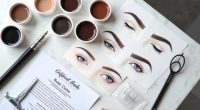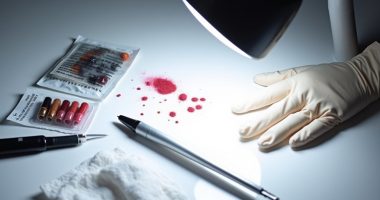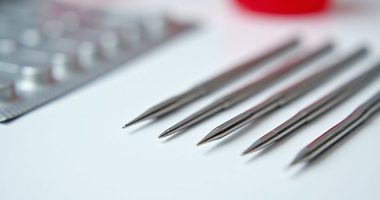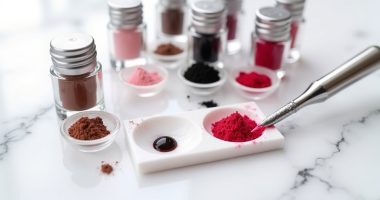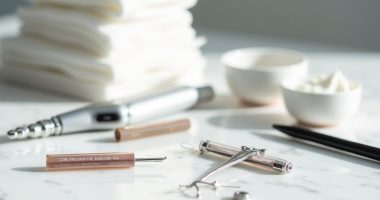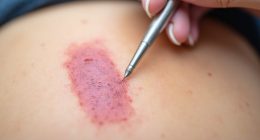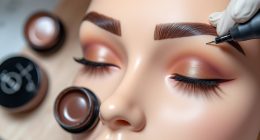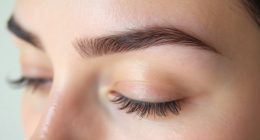Successful permanent makeup requires specific gear. Quality machines – rotary or digital – form the foundation, while pen-style and wireless options offer flexibility. High-grade pigments prevent unwanted color shifts. Single-use needles in various configurations create different effects. Don't skimp on safety equipment: gloves, masks, and proper sterilization tools are non-negotiable. Mapping tools guarantee symmetry, while topical anesthetics keep clients comfortable. The right equipment separates professionals from pretenders.

While many aspiring permanent makeup artists focus solely on perfecting their technique, the tools they choose can make or break their success. The foundation of any successful permanent makeup application begins with selecting the right machine. Rotary machines offer versatility and precision—ideal for artists who handle diverse clientele. Digital machines provide advanced control over speed and depth. Essential during client consultation when discussing pain tolerance. Pen-style options simply feel more natural in hand, especially for detailed work. Some artists swear by wireless machines. Freedom of movement matters, folks. Modern wireless options like the K6003 offer impressive battery life capacity allowing for 2-4 hours of continuous use between charges.
Color selection requires pigments that won't disappoint months later. High-quality, long-lasting pigments aren't cheap, but they're worth every penny. Organic or inorganic? Both have their place. The ability to mix custom shades separates the amateurs from the professionals. Nobody wants eyebrows that turn orange six months later. Fade-resistant formulations exist for a reason. Selecting pigments that harmonize with skin tones is crucial for achieving natural-looking results. Understanding color theory is essential for creating natural-looking enhancements that complement each client's unique features.
Invest in quality pigments—because explaining to clients why their perfect brows now resemble traffic cones isn't in anyone's business plan.
Needles and cartridges might seem like minor details. They're not. Different configurations achieve different effects—period. Single-use, disposable options aren't just about following regulations; they're about respecting clients. Universal cartridge systems save headaches. Fine lines require different gauges than shading. That's just physics.
Safety isn't sexy, but it's non-negotiable. Disposable gloves, face masks, barrier films—use them all. Disinfectants and proper sterilization equipment aren't optional. Sharps containers exist for a reason. Cross-contamination isn't a risk worth taking.
Client comfort dramatically impacts results. Topical anesthetics make the difference between a client who sits still and one who flinches with every stroke. Aftercare products aren't just about selling more stuff; they protect your work. The right cleansers, healing balms, and sun protection guarantee the best results.
Precise mapping tools create symmetry. Eyebrow rulers, calipers, and mapping threads aren't suggestions—they're requirements. Digital mapping devices? Revolutionary for complex cases. Skin markers need to be precise and temporary. Microblading tools must create hair-like strokes that actually look natural.
Supplementary equipment completes the professional setup. Magnifying lamps reveal details invisible to the naked eye. Pigment rings keep colors organized during lengthy sessions. Practice skins save clients from becoming guinea pigs. Before/after documentation protects artists legally. And adjustable chairs? Your back will thank you after an eight-hour session.
Frequently Asked Questions
How Long Does Permanent Makeup Typically Last?
Despite the "permanent" name, permanent makeup typically lasts just 1-3 years. Ironic, right?
Eyebrows fade fastest (12-24 months), while lip color hangs around longer (2-5 years). Numerous longevity factors come into play.
Skin type matters big time—oily-skinned folks see faster fading. Sun exposure? Killer for pigment retention.
Artist skill and pigment quality make huge differences too. Most people need touch-ups every 12-18 months.
Nothing lasts forever, especially "permanent" makeup.
Is Permanent Makeup Application Painful?
Permanent makeup hurts, but not like medieval torture. Most clients report minimal discomfort—think scratching sensation or light pressure.
Pain varies wildly. Sensitive areas like lips? Definitely more ouchy.
Pain management techniques make a massive difference. Topical numbing creams (lidocaine-based) applied 15-60 minutes before treatment greatly reduce sensation.
Client comfort also depends on skin type, artist technique, and psychological factors. Some people barely flinch. Others? Drama queens. Everyone's different.
What Certifications Should Permanent Makeup Artists Have?
Permanent makeup artists need serious credentials. Period. Bloodborne pathogens certification is non-negotiable—it's an OSHA thing.
State licensing requirements vary wildly; some demand cosmetology backgrounds, others specific PMU licenses. Apprenticeship hours? Usually 500-1000. Ouch.
Professional certifications from organizations like SPCP or AAM add credibility. Shows the artist knows their stuff.
Specialized technique training matters too—microblading, scalp work, whatever.
Bottom line: proper artist training equals safer procedures and better results.
How Much Does Permanent Makeup Cost?
Permanent makeup isn't cheap. Costs range from $300-$800 per procedure, with eyebrows running $400-$600 and eyeliner $200-$300 per lid.
Multiple cost factors are at play here. Geographic location matters—big cities, bigger bills. Artist experience? More skills, more dollars.
Pricing variations exist everywhere. Studio reputation, materials quality, procedure complexity—they all jack up prices.
And don't forget those touch-ups every few years. Beauty's permanent, but your wallet feels the temporary pain.
What Are the Risks or Side Effects of Permanent Makeup?
Permanent makeup isn't risk-free. Period.
Infection prevention is essential—hepatitis, HIV, and staph can spread through unsterile needles. Yikes.
Allergic reactions happen too, especially with certain pigments. Some people's skin sensitivity leads to redness, swelling, or granulomas.
Scarring? Absolutely possible. Pigment migration changes how it looks over time.
MRIs can cause burning sensations around the makeup.
And if you hate the results? Tough luck—removal is difficult and expensive. Not exactly consequence-free beauty.

